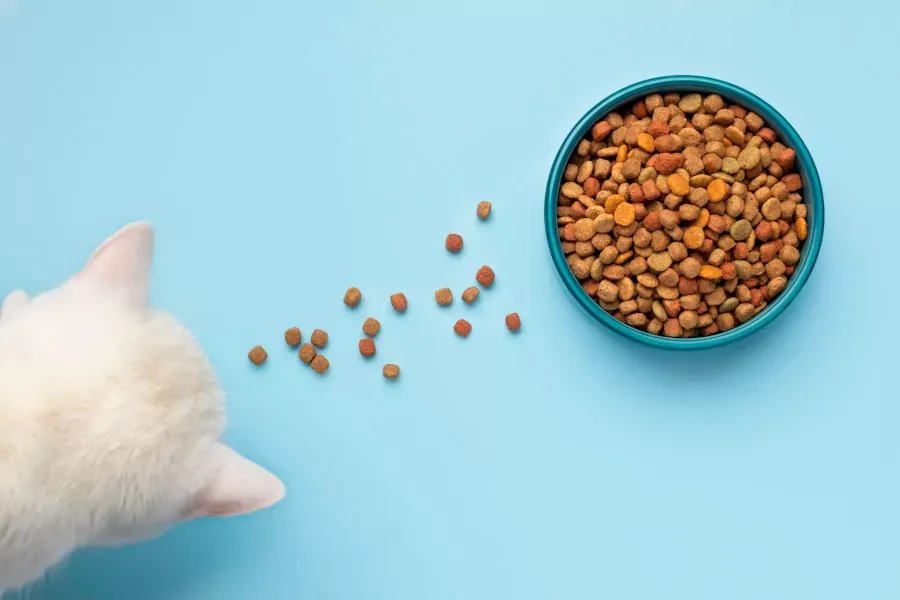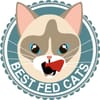Untruths We Tell Ourselves About Cat Food
To willingly continue to buy into the cat food industry, we tell ourselves certain things. These beliefs become ingrained, we behave accordingly and form habits. We continue to buy cat food without even thinking about it.

We base what we do – and do not do – on our beliefs, what we were taught and our observations. For us to continue to do something, we have to believe in what we are doing.
As long as we believe that commercial cat food is healthy, safe and the best option, we will continue to buy it. We rarely appreciate it when information comes along that kicks up our belief system.
But to make meaningful changes, we have to revisit our convictions. For the most part, beliefs about commercial cat foods are untrue.
This article challenges the four most common things we tell ourselves about commercial diets.
1. My cat LOVES his food!
Anyone who has ever watched a cat devour pelleted food will agree that they must really love it. And if they love something so much, how bad can it be?
How much our cats love ultra processed cat food is not a reflection of how good it is for them. As much as we love ultra processed food, too much is bad for us – no matter how we look at it.
Love for a food is not a measure of its healthfulness.
...love has nothing to do with it
Kids love candy and will live on it if we let them. But we know better, so we keep a tight lid on the candy jar. How many kids love Brussels sprouts?
Not that many! This does not mean that they should not be eating them. Quite the contrary.
Our parents and their parents spent a lot of time to teach us to embrace and love what nature provides us with. Over the course of many years, they taught us moderation, treat rationing and making healthy choices.
We ourselves put in the hard work to convince our kids to love healthy eating. Similarly, we teach our cats what to eat and we provide the food for them.
...our cats eat what we give them
Cats in our homes are part of our households. Whether food is healthful or not, safe or not, cats resign to eating what we offer them. They are dependent on us and they do not have other food options. To stay alive, they eat what we offer them.
The previous article revealed how deceiving looks can be when it comes to food. It clearly shows how the convergence of several factors can be misconstrued as love for a food.

2. My cats eat cat food and they're fine!
It is true that we can live for quite some time on ultra processed foods before the cracks start to show. And start to show they will. Given enough time, all junk food diets will start to break down health.
Ultra processed cat food is just that – junk food for cats. It is true that cats can digest processed foods, albeit to a limited extent. And not without placing the cat's metabolism under tremendous stress 1.
Notably, cats on a processed, man-made diet rarely show the same levels of health and well-being seen in their wild and feral natives ². And it all comes down to diet.
The one eats what mother nature provides, while the other eats a man-made, ultra processed diet.
...surviving is not thriving
Granted, cats around the world do survive on commercial cat foods – even for years. But is it good enough to merely survive? All beings strive to flourish, be optimally healthy and feel great. None of these are attainable on an ultra processed junk diet.
Surviving is to merely exist. It is a struggle to feel good, stay healthy and to keep disease at bay. It is better than starving, but the heaviness of survival is no way to live.
When cats thrive, they are truly alive – vibrant, happy and energetic. They feel good and it shows. Thriving is the ultimate gift we can give ourselves, our families and also the the animals in our care.
3. The label says it's balanced and complete.
The ingredients for commercial cat foods undergo multiple rounds of processing 3, 4. As a result, nutrients are degraded, denatured or rendered useless. More fragile nutrients are destroyed entirely.

So, how do pet food manufacturers overcome this problem?
...nutrients are added back
They first identify any nutritional gaps from cooking and processing. They then add a sleuth of synthetic vitamins and minerals to fill these gaps.
The problem with these synthetic compounds is that they are molecularly and nutritionally inferior to the vitamins and minerals found in raw, unprocessed foods 5.
To ensure the expected 12 month or longer shelf life, cat food is treated heavily with preservatives 6. This is done to 'lock in nutrients and assure freshness'.
...pet food safety trials
Lastly, morally objectionable research is carried out to determine the safety and nutritional adequacy of foods 7. So, when labels state that foods are balanced and complete, one can infer that the food went through all of these processes.
4. Everyone says commercial cat food is safest
Apart from health issues associated with ultra processed foods, wet and dry cat foods come with considerable safety risks, as signified by the endless stream of recalls.
Toxins, chemicals, microorganisms and contaminants pose ongoing threats. To add to the problem, vitamin, mineral and nutrient deficiencies also lead to a good number of recalls. Incorrect formulations further contribute.
The most significant pet food recall is probably the 2007 large scale melamine adulteration scandal. It claimed the lives of thousands upon thousand of pets around the world 8.
Around 2013, a study into vitamin D levels in canned pet food flagged over 20 foods in the USA alone that contained 30 times the required levels of vitamin D3 8.
In 2021, there were 14 pet food recalls – and another 8 in 2022 – as listed on the US Food and Drug Administration website 9. Of course, this list extends only to pet products manufactured in and exported from the USA.
And this list is ever evolving.
The next article promises to be quite fascinating. It takes a look at what cats would choose to eat if they were given the option. A food selection research study revealed pretty compelling results that sheds some light on this interesting issue.


References
1 Griffiths, S. & Ruish, D. (n.d.). Evolutionary nutrition for the cat. In Club Canine. Online booklet retrieved April 29, 2015. Shortened/revised version available from http://www.clubcanine.net/ evolutionary-nutrition-cats.shtml
2 True Carnivores (n.d.). What vets say... Retrieved July 11, 2016, from https://www.truecarnivores. com/what-vets-say/
3 Hofve, J. (2013). 10 reasons why dry food is bad for cats & dogs. In Little Big Cat. Retrieved on March 3, 2022 from https://littlebigcat.com/why-dry-food-is-bad-for-cats-and-dogs/#
4 Thixton, S (2016). How many times are ingredients cooked in kibble pet foods? In Truth About Pet Food. Retrieved on March 3, 2022, from https://truthaboutpetfood.com/how-many-times-are-ingredients-cooked-in-kibble-pet-foods/
5 Clement, B.R. (2010). Supplements Exposed: The truth they don't want you to know about vitamins, minerals, and their effects on your health. Franklin Lakes, New Jersey: New Page Books.
6 Chanadang, S., Koppel, K. & Aldrich, G. (2016). The impact of rendered protein meal oxidation level on shelf-life, sensory characteristics and acceptability in extruded pet food. Animals, 6(44), 1 – 17.
7 Wysong, R.L. (2002). The truth about pet foods. Midland, Michigan: Inquiry Press.
8 Brough, E. (2020). The effects of feeding a raw meat-based diet on the behaviour and health of cats. Unpublished Honours Dissertation, Manchester Metropolitan University, Manchester, United Kingdom.
9 US Food & Drug Administration (n.d.). Recalls & withdrawals. Retrieved February 2, 2023, from https://www.fda.gov/animal-veterinary/safety-health/recalls-withdrawals
Disclaimer
The information provided on the Bestfedcats.com website is educational and informational. We are here to give guidance on how to feed a properly balanced raw diet. We also offer advice on how to improve the diet of the modern house cat. Please note that we are not veterinarians. We are not here to give veterinary advice. Best Fed Cats will not be held responsible for any adverse reactions to your cat based on the information on our website. The health of your cat depends entirely on you. We expect you to use your knowledge of your cats, their circumstances and their health – in conjunction with a trusted veterinarian – to determine if any advice provided on this site is appropriate for your cats.

